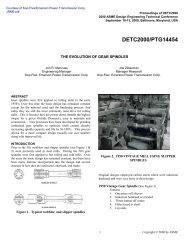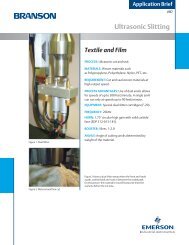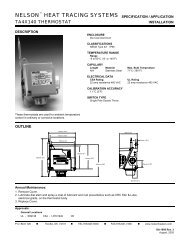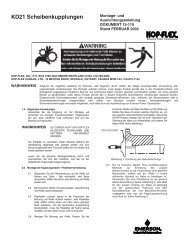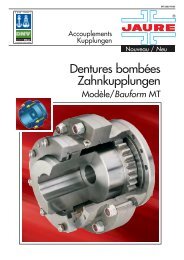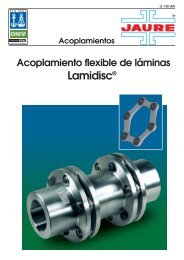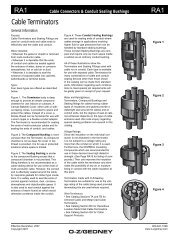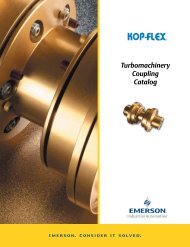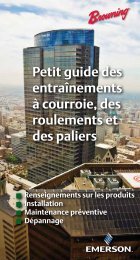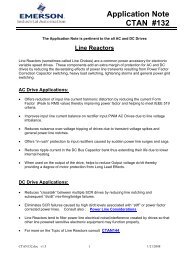Kop-Flex Industrial Coupling Product Catalog - Form 8887E
Kop-Flex Industrial Coupling Product Catalog - Form 8887E
Kop-Flex Industrial Coupling Product Catalog - Form 8887E
Create successful ePaper yourself
Turn your PDF publications into a flip-book with our unique Google optimized e-Paper software.
MAXXUS ® Universal Joints<br />
Selection Procedure<br />
The following series of calculations will help<br />
you choose the right universal driveshaft,<br />
but it is a preliminary guide. Some important<br />
factors cannot be easily quantified. For<br />
example, you should consider the type of<br />
machine, peripheral equipment, and operating<br />
conditions. Take advantage of our expertise<br />
throughout the selection process. Confirm the<br />
final selection with our engineers.<br />
1. Calculate application (operating) torque<br />
HP x 63,000<br />
T a<br />
=<br />
Speed (rpm)<br />
2. Determine peak torque of the<br />
application (T p<br />
)<br />
3. Determine the suggested selection<br />
factor (SF) required from the table<br />
below.<br />
4. Compare your application’s torque<br />
with the driveshaft torque capacities<br />
shown in charts on page 254.<br />
T dr<br />
= Reversing Endurance torque limit<br />
(lb.-in.)<br />
T do<br />
= Non-Reversing Endurance<br />
torque<br />
limit (lb.-in.)<br />
T s<br />
= Yield torque limit (lb.-in.)<br />
In order for a universal driveshaft to<br />
be suitable for your application:<br />
ENDURANCE LIMIT CHECK<br />
T a<br />
x SF e<br />
>T dr<br />
(Reversing endurance<br />
torque limit) or >T do<br />
(Non-Reversing<br />
endurance limit torque limit), depending<br />
on whether application is reversing or<br />
non-reversing.<br />
YIELD LIMIT CHECK<br />
If T p<br />
(Torque Amplification Torque) is<br />
known:<br />
T p<br />
x 1.25 > T s<br />
(Yield torque limit)<br />
If Tp is not known, check select to assure:<br />
T a<br />
x SF y<br />
> T s<br />
(Yield torque limit)<br />
5. Also consider:<br />
n Diameter limitations<br />
n Length limitations<br />
n Angular (misalignment) requirements<br />
n Length compensation feature<br />
(slide) requirements<br />
6. Bearing expected life calculation<br />
(B 10<br />
or L e<br />
-Hours)<br />
n Determine angle factor (KA) from<br />
the chart below<br />
n Determine speed factor (KS) from<br />
the chart below<br />
n Select bearing life factor (KB)<br />
from the charts on page 254.<br />
Calculate bearing life hours (B 10<br />
) as follows:<br />
2.907<br />
KB x KA x KS<br />
B 10<br />
(hours) = 9000 x<br />
[ ]<br />
Note: T a<br />
(application torque) is in lb. in.<br />
Note: The calculated bearing life hours<br />
(B 10<br />
) should be at least 5,000 hours.<br />
Since most mill applications will run at<br />
various torques and speeds, the normal<br />
expected B 10<br />
life should be based on the<br />
expected duty cycle.<br />
LE = 1<br />
N 1<br />
+ N 2<br />
+ N 3<br />
L 1<br />
L 2<br />
L 3<br />
T a<br />
+........etc.<br />
N 1<br />
= Fraction of time at operating condition 1<br />
L 1<br />
= Life expectancy at operating condition 1<br />
Let’s assume an example application 1609<br />
HP @ 680-1360 RPM operating angle is 3<br />
degrees of misalignment.<br />
#260D MAXXUS Driveshaft.<br />
Torque Speed Expect Cal B10<br />
lb-in. RPM Time % Hours<br />
149,147 680 50% 9,578<br />
99,431 1020 25% 20,949<br />
74,573 1360 25% 36,502<br />
Expected B-10 Life<br />
L e<br />
= 1<br />
t1 + t2 + t3<br />
L1 L2 L3<br />
If the duty cycle is not known, the normal<br />
expected B10 life will be calculated assuming<br />
the following duty cycle.<br />
Torque Speed Expect<br />
lb-in. RPM Time %<br />
Maximum Minimum 33.3%<br />
Average Average 33.3%<br />
Minimum Maximum 33.3%<br />
Lets assume the example application<br />
above (#260D MAXXUS) 1609 HP @<br />
680-1360 RPM operating angle is 3 degrees<br />
of misalignment.<br />
Torque Speed Expect Cal B 10<br />
lb-in. RPM Time % Hours<br />
149,147 680 33.3% 9,578<br />
99,431 1020 33.3% 20,949<br />
74,573 1360 33.3% 36,502<br />
Note: The calculated expected bearing life<br />
hours (B 10<br />
) should be at least 5000<br />
hours<br />
KOP-FLEX uses specialized<br />
computer programs that will select<br />
a universal joint custom-designed<br />
to suit your application.<br />
Suggested Selection Factor (SF)<br />
Suggested Selection Factors<br />
APPLICATION<br />
SF<br />
e<br />
SF<br />
y<br />
Auxiliary<br />
Mill Equipment: Coilers, Levelers, Pinch Rolls,<br />
1.<br />
5<br />
2. 5<br />
Tinning Lines, Pickle Lines<br />
Wire, Small Bar & Rod Mills: All Stands.<br />
Medium Bar & Section Mills: Finishing Stands.<br />
Cold<br />
Mills: Non-Reversing.<br />
1.75<br />
3. 0<br />
Medium Bar & Section Mills: Roughing Stands.<br />
Large Bar & Section Mills: Finishing Stands.<br />
Hot<br />
Strip Mills: Non-Reversing Finishing Stands.<br />
2.<br />
0<br />
4. 0<br />
Cold Mills: Reversing.<br />
Large Bar & Section Mills: Non-Reversing Roughing Stands.<br />
Hot<br />
Strip Mills: Non-Reversing Roughing Stnads.<br />
2.<br />
5<br />
5. 0<br />
Edgers, Non-Reversing.<br />
Hot<br />
Strip Mills: Reversing Roughing Stands.<br />
3.<br />
0<br />
6. 0<br />
Large Bar & Section Mills: Reversing Roughing Stands.<br />
Edgers, Reversing. Steckel Mills.<br />
Reversing<br />
Slab, Plate and Blooming Mills.<br />
4.<br />
0<br />
8. 0<br />
Note 1 — use SF e<br />
for selection based on Endurance. Note 2 — use SF y<br />
for selection based on Yield.<br />
Note 3 — These selection factors are only to be used as general guide. Lower or Higher values may be<br />
acceptable based on experience. Confirm final selection with engineering.<br />
Speed Factor (KS)<br />
Angle Factor<br />
(KA)<br />
R OTATION SPEED ANGLE (Degree)<br />
( RPM) Note 1 KS<br />
Note<br />
1<br />
KA<br />
100<br />
2.17<br />
3 1.00<br />
200<br />
1.72<br />
4 0.91<br />
300<br />
1.50<br />
5 0.84<br />
400<br />
1.36<br />
6 0.79<br />
500<br />
1.26<br />
7 0.75<br />
600<br />
1.19<br />
8 0.71<br />
700<br />
1.13<br />
9 0.69<br />
800<br />
1.08<br />
10<br />
0.66<br />
900<br />
1.04<br />
Note 1 — For angles<br />
1000<br />
1.00<br />
greater than<br />
1100<br />
0.97<br />
10 degrees,<br />
1200<br />
0.94<br />
consult<br />
1300<br />
0.92<br />
<strong>Kop</strong>-<strong>Flex</strong>.<br />
1400<br />
0.89<br />
1500<br />
0.87<br />
Note 1 — For speeds<br />
greater than<br />
1500 rpm, consult<br />
<strong>Kop</strong>-<strong>Flex</strong>.<br />
253





